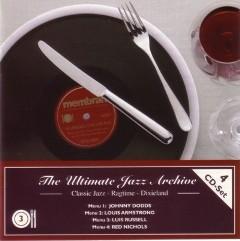The Ultimate Jazz Archive CD12 - Red Nichols [1927-1928]
The Ultimate Jazz Archive CD 12 - Red Nichols [1927-1928] [2005]

01.Riverboat Shuffle 02.Indiana 03.Dinah 04.On the Alamo 05.Rose of Washington 06.Peg O My Heart 07.Sweet Georgia Brown 08.China Boy 09.The Shiek of Araby 10.Corrinne 11.Fan It 12.Harlem Twist 13.The Darktown Strutters Ball 14.Davenport Blues 15.Original Dixieland One Step 16.Shim Me Sha Wabble
Overrated in Europe in the early '30s when his records (but not those of his black contemporaries) were widely available and then later underrated and often unfairly called a Bix imitator, Red Nichols was actually one of the finest cornetists to emerge from the '20s. An expert improviser whose emotional depth did not reach as deep as Bix or Louis Armstrong, Nichols was in many ways a hustler, participating in as many recording sessions (often under pseudonyms) as any other horn player of the era, cutting sessions as Red Nichols & His Five Pennies, the Arkansas Travelers, the Red Heads, the Louisiana Rhythm Kings, and the Charleston Chasers, among others, usually with similar personnel. Nichols studied cornet with his father, a college music teacher. After moving from Utah to New York in 1923, Nichols, an excellent sight-reader who could always be relied upon to add a bit of jazz to a dance band recording, quickly became in great demand. His own sessions at first featured trombonist Miff Mole and Jimmy Dorsey on alto and clarinet, playing advanced music that utilized unusual intervals, whole-tone scales, and often the timpani of Vic Berton along with hot ensembles. Later on in the decade his sidemen included such young greats as Benny Goodman, Glenn Miller, Jack Teagarden, Pee Wee Russell, Joe Venuti, Eddie Lang, Adrian Rollini, Gene Krupa, and the wonderful mellophone specialist Dudley Fosdick, among others; their version of "Ida" was a surprise hit. Although still using the main name of the Five Pennies, Nichols' bands were often quite a bit larger, and by 1929 he was alternating sessions featuring bigger commercial orchestras with small combos. At first Nichols weathered the Depression well with work in shows, but by 1932 his long string of recordings came to an end. He headed a so-so swing band up until 1942, left music for a couple of years, and for a few months in 1944 was with Glen Gray's Casa Loma Orchestra. Later that year he re-formed the Five Pennies as a Dixieland sextet and, particularly after bass saxophonist Joe Rushton became a permanent member, it was one of the finer traditional jazz bands of the next 20 years. Nichols recorded several memorable hot versions of "Battle Hymn of the Republic," the best being in 1959. That same year a highly enjoyable if rather fictional Hollywood movie called The Five Pennies (and featuring Nichols' cornet solos and Danny Kaye's acting) made Red into a national celebrity at the twilight of his long career. Nichols' earlier sessions have been reissued in piecemeal fashion during the digital era, with later albums remaining unavailable. ---Scott Yanow, Rovi
Zmieniony (Środa, 06 Luty 2013 15:08)








